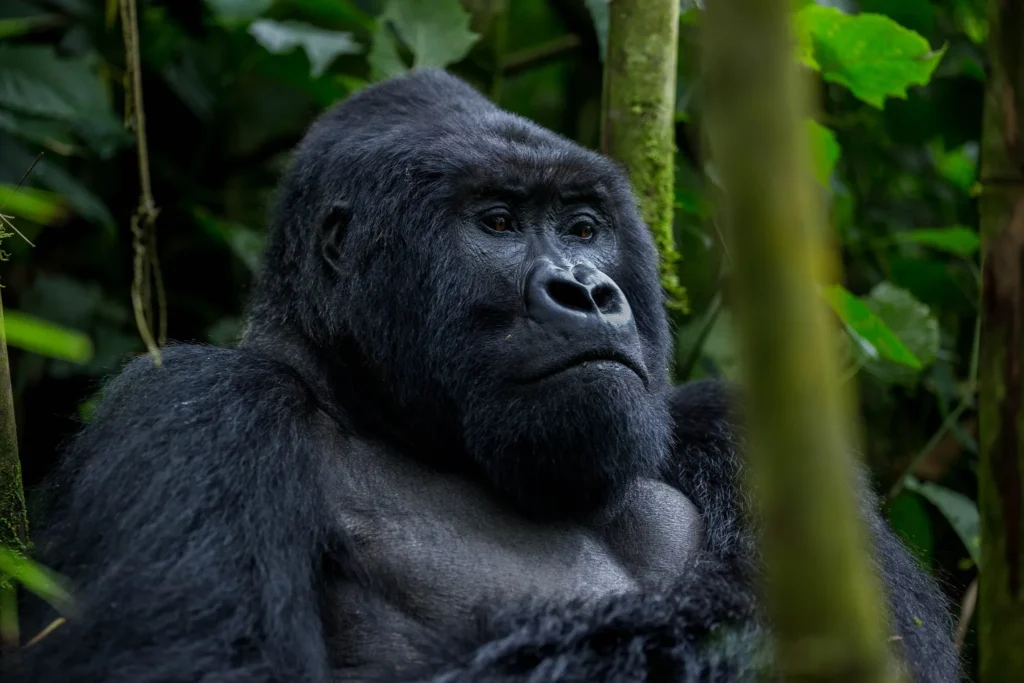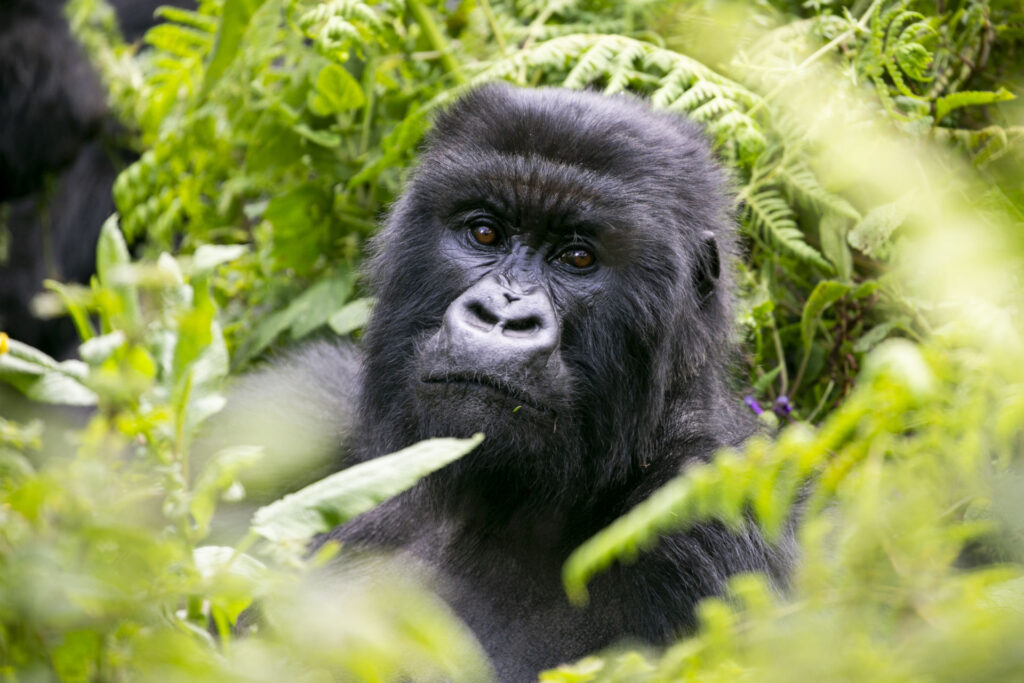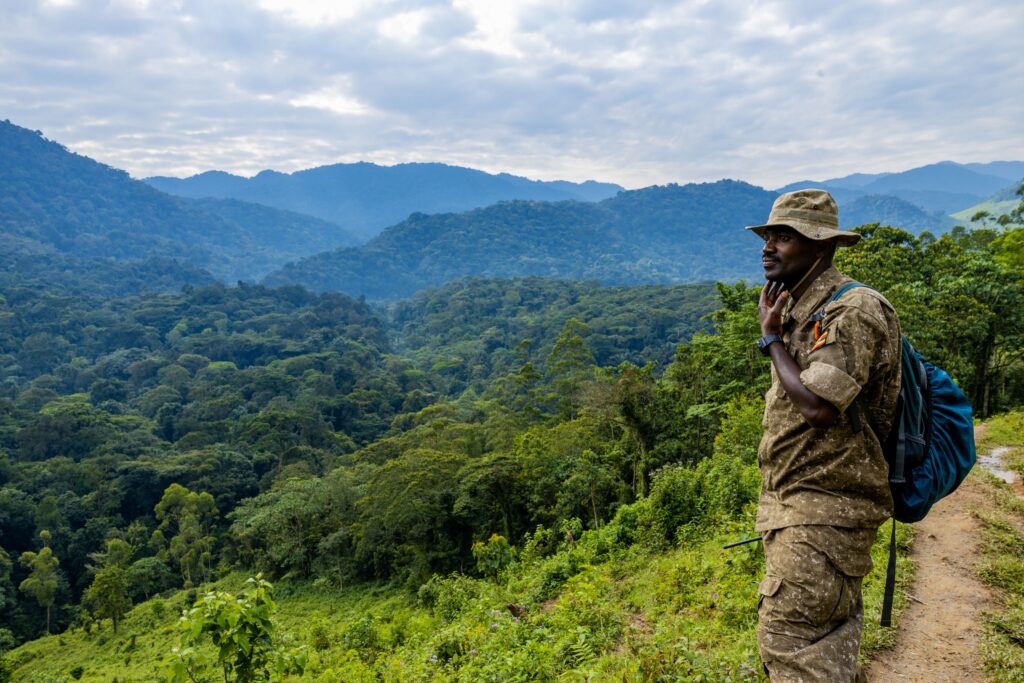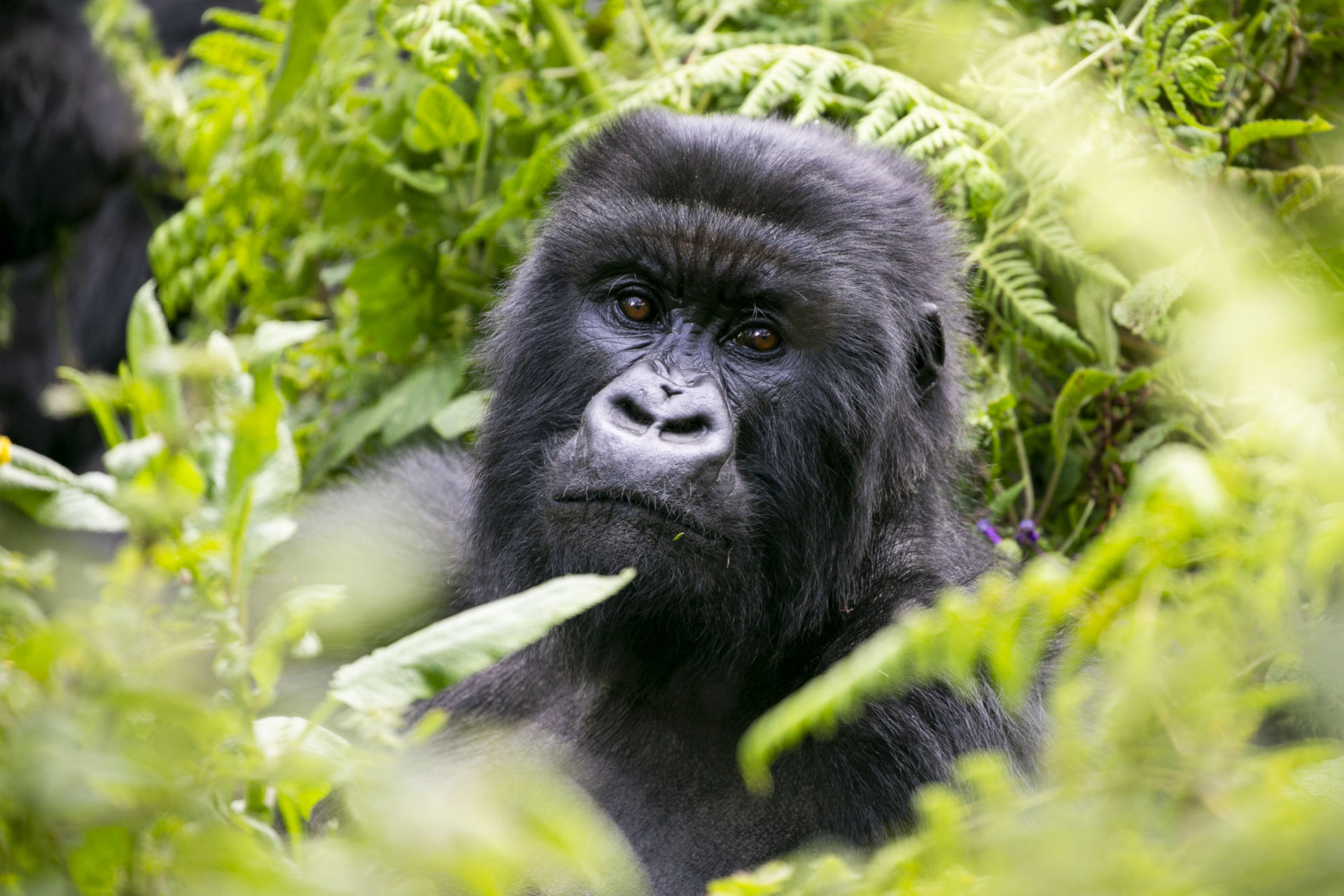Meeting a Silverback Gorilla in the wild is a once-in-a-lifetime experience. These adult male gorillas – with a silvery saddle of hair on their back – are immense and gentle: a typical silverback weighs about 195 kg and can lift over 800 kg. They lead family groups through the misty forests of the Virunga Mountains. In Rwanda’s Volcanoes National Park, you have the best chance to encounter these majestic mountain gorillas (the world’s largest primate, up to 200 kg). There are only around 1,000 of these endangered apes left in the wild, so Rwanda’s conservation efforts make every encounter especially precious. In this guide, we’ll explain why Rwanda stands out for gorilla trekking, how to plan your trip (permits, seasons, preparation), a sample 5-day itinerary, and practical tips for a safe, respectful adventure. Whether you’re an adventure traveler or wildlife enthusiast, you’ll find everything you need to plan your Silverback Gorilla trekking safari in Rwanda (with brief comparisons to Uganda and the DRC for context).
Why Choose Rwanda for Silverback Gorilla Trekking?
Rwanda’s Volcanoes National Park is the premier destination for silverback gorilla trekking. The park is just a ~3-hour drive from Kigali – making it much more accessible than some other gorilla areas. Rwanda has heavily invested in tourism infrastructure: paved roads, comfortable lodges (from budget to luxury at Bisate or Le Bambou), and professional guides ensure a smooth experience. Park authorities enforce strict trekking protocols (with a maximum of 8 visitors per gorilla group and a one-hour viewing time), which keeps encounters safe and low-impact. Rwanda is also extremely safe and politically stable, giving travelers confidence. Importantly, Rwanda has a proven track record in conservation: the number of mountain gorillas has steadily increased under its watch, and today, over 600 gorillas live in Rwanda alone. In short, choosing Rwanda means well-maintained trails, reliable logistics, and a strong conservation legacy behind your trek.
For comparison: Uganda (Bwindi/Mgahinga) has a larger silverback gorilla population and slightly cheaper permits (around US$800), but the terrain is generally steeper and wetter, and roads to the parks are rougher. DRC (Virunga National Park) used to offer gorilla treks at a lower cost (about US$400), but security issues have kept Virunga closed to tourists (the only other mountain-gorilla site is Uganda’s Mgahinga NP). In contrast, Rwanda’s Volcanoes NP is known for its excellent trail network and ranger presence, making it the most straightforward option for a first-time gorilla trekker.
Planning Your Silverback Gorilla Trek in Rwanda

- Permits: A Rwanda gorilla permit currently costs about US$1,500 per person (foreign residents in Africa pay US$500, Rwandans/EAC nationals US$200). Because daily permits are strictly limited (96 per day in Volcanoes NP, 8 per family), you must book well in advance through the My Trip Rwanda portal or a trusted tour operator. Many trekkers book permits as soon as their travel dates are fixed (6+ months ahead) to avoid disappointment. (RDB occasionally offers off-season discounts for bookings combined with stays in other parks, but these require planning.)
- Best Time to Trek: Rwanda’s climate allows year-round gorilla trekking, but the dry seasons are easiest. The long dry season (June–September) and the short dry spell (mid-December to February) offer the best hiking conditions. Trails will be less muddy and rain less frequently, making the trek more comfortable. The rainy periods (March–May and October–November) do have steamy jungles and thick foliage, but they also mean fewer visitors and often greener scenery – some experienced hikers even snag cheaper permits then. In any season, be prepared for sudden mountain showers and possibly slippery paths.
- Physical Preparation: Gorilla treks can be physically demanding. Hikes typically last 1–2 hours (depending on how far a gorilla group is), often on steep, muddy slopes through dense forest. Light fitness training (regular hikes, jogging, or cycling) in the months before your trip will help a lot. If you’re concerned about your stamina or carrying luggage, consider hiring a local porter (about $15–$20) to carry your backpack. Porters make the trek much easier, and it helps support the local economy. Remember that the park’s elevation is moderate-high (2,500–4,500 m), so allow a day to acclimate in Kigali if you have time, and bring a warm layer for the forest.
- Packing List: Pack for tropical highland conditions. Essentials include sturdy waterproof hiking boots (for mud and roots) and lightweight, long-sleeve, quick-dry clothes. A waterproof jacket or poncho is a must (rains come quickly even in the “dry” season), and gloves are handy for bushwhacking through vines. Protect against insects with repellent and long sleeves. Bring at least 1.5–2 L of water and some energy snacks for the trek. A daypack will hold your supplies. Also pack sunscreen, sunglasses (the sun can be strong when the canopy opens), and any personal meds (e.g., altitude or motion sickness remedies). Binoculars and a camera with a good zoom lens are nice for photos – but no flash please (flashes startle gorillas). Finally, don’t forget a reusable bag to avoid litter and respect local environmental guidelines.

Sample 5-Day Silverback Gorilla Trekking Itinerary in Rwanda
- Day 1: Arrive in Kigali. Touch down in Kigali and check into your hotel. Spend the afternoon resting or exploring Kigali’s sights – the Genocide Memorial, vibrant markets, and friendly neighborhoods. Kigali is safe and modern, a gentle introduction to Rwanda. Enjoy a local meal (like brochettes or Rwandan stew) and rest early to start your trek well-prepared.
- Day 2: Transfer to Volcanoes NP. After breakfast, drive north (~2–3 hours) to the foothills of the Virungas. Arrive in Musanze (Ruhengeri) and check into a lodge near the park. In the afternoon, attend the mandatory pre-trek briefing at the park offices: rangers and guides will review safety, rules (stay 7m away, 1-hour viewing), and hand out permits. If time permits, visit a nearby cultural site like the Iby’Iwacu Village to learn about Rwandan traditions. Overnight near the park (many lodges have mountain views).
- Day 3: Silverback Gorilla Trekking Day. Wake up early for a hearty breakfast, then head to the park headquarters. You’ll join a group of up to 8 trekkers with a guide, tracker, and local ranger. Hiking boots on, trekking poles ready, you’ll set off into bamboo forests and misty slopes in search of your gorilla family. Trek duration is unpredictable (2–6 hours), but when you find the gorillas, prepare for an unforgettable encounter. Spend up to one hour observing the family – likely led by a huge silverback – as they eat, groom, and lounge on the forest floor. Remember to keep silent and keep your distance. After the trek, return to your lodge to celebrate with lunch. The rest of the day is yours to relax (many lodges offer spa treatments or nearby nature walks).
- Day 4: Optional Second Trek or Golden Monkeys. If you’ve secured a second permit, you can trek again to see a different gorilla group. Otherwise, try the golden monkey trekking permit (about $100) – these small, golden-furred monkeys live in Volcanoes NP’s bamboo zone, and the hike is shorter but still beautiful. Alternatively, visit the Dian Fossey Gorilla Fund’s Karisoke research center or simply enjoy a leisurely day around Musanze. In the evening, mingle with fellow travelers or enjoy a traditional meal with locals.
- Day 5: Return to Kigali and Depart. After breakfast, drive back to Kigali. On the way, you might stop at a craft market for souvenirs (Rwanda is famous for woven baskets and handmade coffee). Depending on your flight time, you could fit in a short city tour or just savor the last views of the countryside. Fly home or onward that afternoon/evening. Tip: Many tour operators (for example, MyTripRwanda or GorillaTrekRwanda tours) can customize this itinerary – you could easily add extra days, combine with a safari in Akagera or chimp treks in Nyungwe, or adjust activities to your interests.
Tips for a Successful Gorilla Trek
- Respect gorilla etiquette. Always follow your guide’s instructions and keep a safe distance (about 7 meters). Avoid any sudden movements or loud noises; let the gorillas approach you if they are curious. Do not use flash photography, as it disturbs the animals (a good telephoto lens is recommended). When the silverback chest-beats or throws vegetation as a display, remain calm and speak in a soft voice. Remember, you are a visitor in their home – no touching, feeding, eating, or smoking near the gorillas.
- Prepare for the trail. Silverback Gorilla trekking can be slippery and sweaty. Wear layers that you can shed or add as you warm up. Use gloves to help grip rough vegetation. Hiring a porter (around $15–$20) not only carries your bag but also supports the local community – and it’s strongly encouraged, especially if you have a backpack. Take rests as needed; your guides and porters will assist if the trail is challenging.
- Stay positive and patient. Every trek is different – sometimes gorillas are found quickly, other times the hike is long. Bring an adventurous spirit and watch how each group interacts. Even a short glimpse or the sounds of gorillas in the distance is exhilarating. Finally, follow all park rules to keep both you and the gorillas safe (rules are there because the gorillas are very sensitive to disease and stress).
- Engage respectfully with local culture. A simple “Murakoze” (thank you) in Kinyarwanda or a smile goes a long way. If you hire guides or porters, tip them well – it benefits families and shows gratitude. Choose eco-friendly lodgings (many Volcanoes-area hotels are certified conservation partners). Pack out any trash and avoid single-use plastics. By being a conscientious traveler, you honor both the gorillas and the Rwandan communities that host you.
Conservation and Responsible Tourism

Your trek fee does more than pay for your adventure – it fuels conservation and community development. In Rwanda, a fixed percentage of gorilla permit revenue is directly shared with local villages. This has funded schools, clinics, and clean water projects for families near Volcanoes National Park. Today, mountain gorillas are a rare conservation success story: decades of protection have seen their numbers rise from only a few hundred to over 1,000 across the region, prompting a downgrade from “Critically Endangered” to “Endangered.” Rwanda’s annual Kwita Izina naming ceremony (where baby gorillas get names) further celebrates these gains. When you trek respectfully – following park rules and choosing sustainable lodges – you become part of this success. The high permit fees (about 1% of Rwanda’s GDP comes from gorilla tourism) help maintain the park and support the people living nearby. In short, eco-friendly travel in Rwanda’s Gorilla Parks means protecting gentle giants for generations to come.
Conclusion
A Silverback Gorilla trek in Rwanda is an experience few travelers will ever forget. From the misty mountain sunrise to the quiet thrill of seeing a silverback gorilla with its family, every moment is extraordinary. With good planning – securing your $1,500 permit, traveling in the dry season, packing right, and going with knowledgeable guides – you’ll make the most of this adventure. Start planning your trip today! Book your permit through MyTripRwanda or GorillaTrekRwanda. to craft your perfect itinerary. Trekking with a silverback in Volcanoes National Park is not just a safari – it’s a personal encounter with one of Earth’s last great apes. Enjoy every moment of this once-in-a-lifetime journey.
